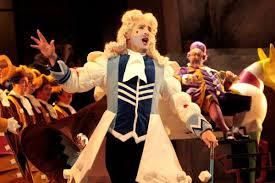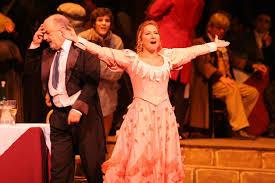Originally taking place in the sensuous demi-monde of 1840s Paris, in LA Opera’s current iteration director/production designer Marta Domingo has reset Giuseppe Verdi’s La Traviata during the Roaring Twenties. This revival of Domingo’s Art Deco vision of Verdi’s vintage version injects new visual flare into the opera that was first performed in Venice in 1853. Although the original’s “demi-mondaine” dames (who, in today’s parlance, might be called “high class hookers”) have been replaced by flappers in Domingo’s rendition, the plot of Verdi’s opera (Francesco Maria Piave’s libretto adapted Alexandre Dumas fils’ 1848 novel La Dame aux Camélias) is essentially the same.
[PLOT SPOILER ALERT!] The ardent Alfredo (played by Kosovo tenor Rame Lahaj through June 13 and until June 22 by New York tenor Charles Castronovo) professes his love for the sexually alluring Violetta (Romanian Soprano Adele Zaharia) at a party the enchantress has thrown at the salon in her Parisian house. Alfredo woos this “woman with a past” and they become a loving couple, forsaking all else as they relocate to Violetta’s home in the French countryside, where the lovers pursue their romance.
Of course, complications ensue. In the Western canon sexually promiscuous woman must almost always pay for their “crimes” - especially if they have the temerity of actually enjoying sex. This is a convention stretching at least as far back as Jezebel in the Old Testament. Pay attention, ladies: Nature may have endowed you with a clitoris which has only one purpose, BUT if you dare to use it for that purpose (with very narrowly defined possible exceptions). God help you! (Even if he/she/it gave you said clit.)
Embodying bourgeois behavior and probity, Alfredo’s father Germont (baritone Vitaliy Bilyy from Odessa, Ukraine through June 13; Russian baritone Igor Golovatenko through June 22) intervenes, sticking his unwelcome nose into the young lovers’ business and private affair. Compounding matters are Violetta’s health problems, ensuring that she will “pay” for the offense of daring to be sexually active.
(If the storyline sounds familiar, Greta Garbo’s doomed paramour in the 1937 classic movie Camille is also derived from La Dame aux Camélias - hence her character’s eponymous name in the screen drama directed by Hollywood’s ultimate “woman’s director,” George Cukor.)
In Act I, during the party at her salon, Violetta and Alfredo sing the exquisite duet “Libiamo ne’ lieti calici” (“A chalice we’ll drain”), accompanied by the chorus. Verdi’s music here is as ebullient and joyous as it is at other times overwrought and ominous in La Traviata. The lyrics include the high living Violetta’s rhapsodic verse (like the rest of the opera the words are sung in Verdi’s native Italian but like LA Opera’s supertitles, they are translated into English below):
“With you, with you I’ll be able to share
my cheerful times.
Everything is foolish in the world
which is not pleasure.
Let's enjoy ourselves, for fleeting and quick
the delight of love is:
it’s a flower that blooms and dies
and can no longer be enjoyed.
Let’s enjoy ourselves, fervent
flattering voice invites us.”
Of course, for devoting her life to hedonism, Violetta has to be punished! Be that as it may, the scenic transition from Violetta’s salon to her bedroom after she becomes faint (foreshadowing her doom for daring to pursue happiness) is creatively rendered. Usually, when the scenery and location change, a character moves from one place to another or the curtain drops for stagehands to execute an act change. But in the first act, it is the scenery - instead of the performer or crew members - that rather creatively moves.
This production’s other great sequence takes place during another party, this time at the Parisian palace of Violetta’s friend Flora (Angeleno mezzo-soprano Peabody Southwell). Here, Domingo outdoes herself with the Art Deco motif - scantily clad flappers (in Verdi’s original they are identified as “gypsies”) and a male solo dancer Louis A. Williams of Missouri - hoof to Kitty McNamee’s sensuous, glittery choreography. (In one scene the production’s 1920s ambiance is enhanced by the appearance onstage of an actual classic auto from the era.)
On a balcony above Flora’s salon overlooking festivities where one almost expects to see Zelda and F. Scott Fitzgerald frenetically dancing the “Charleston”, Black musicians appear to be playing Roaring Twenties’ type tunes. However, although visually the panorama on the boards is stunning to behold, musically it is a bit dissonant, as viewing the band one anticipates hearing jazz, but instead we hear Verdi’s orchestral music, being performed under the baton of conductor James Conlon. It’s a bit of a musical mismatch and jumble although to be sure optically opulent, with great dancing.
After two intermissions, as Violetta prepares to meet her fate in this almost three-hour long show, for about 35 excruciatingly long minutes Act III is a weepfest. A young lady sitting to my right actually removed a number of tissues from her purse to wipe copious tears away while Violetta received the ultimate punishment for her “wicked, wicked” ways. I was sad to see her go too - the (apparently) quite tall Adela Zaharia is extremely captivating as Violetta. Her rapturous singing earned Zaharia numerous ovations and cries of “Brava!” from the LA Op aud. Dressed to the nines, she accentuated her curvaceous physique by standing at angles with her hip provocatively thrust and so on. Being from Romania, Zaharia may not be a vampire, but one could say regarding her Violetta that “the lady is a vamp” - and, along with Verdi’s sonorous score, well worth the price of admission.
To be fair, La Traviata does much more than merely perpetrate and perpetuate the trope of uninhibited women suffering for their orgasms and the ones they cause others to enjoy. The story criticizes Germont for his rigidity and narrow-minded, outmoded mores. Far from being a mere frippery and trollop, Violetta reveals herself to be an individual of integrity, capable of great self sacrifice and true love. Hopefully, creators in various art forms will come to embrace and celebrate instead of condemn female sexuality in future works. But this step forward away from the guilty obsessions with “sin” and repression will occur when more women create their own operas, novels, plays, films, etc.
Alas, this is the final show of LA Opera’s current season. So until Sept. 13, when LA Opera opens its 2019/20 season with Puccini’s La Boheme, as I’ve written before, Angeleno opera-lovers will be singing (with sincere apologies to Bye Bye Birdie’s Kim McAfee):
“Bye, bye, Verdi
We’re gonna miss you so
Bye, bye, Verdi
Why’d ya have to go…?”
La Traviata is being performed at 2:00 p.m. on June 16 and at 7:30 p.m. on June 19 and June 22 at LA Opera at the Dorothy Chandler Pavilion, 135 N. Grand Ave., L.A. For more info: (213)972-8001; https://www.laopera.org/performances/season-2018-19/la-traviata/.
The third edition of “The Hawaii Movie and Television Book” co-authored by L.A.-based reviewer Ed Rampell is available at: https://mutualpublishing.com/product/the-hawaii-movie-and-television-book/ .



